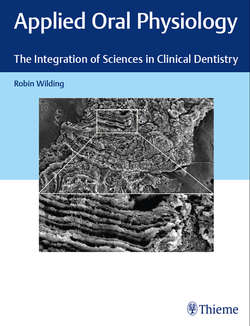Читать книгу Applied Oral Physiology - Robin Wilding - Страница 55
На сайте Литреса книга снята с продажи.
3.6.4 Cementum Formation in Healing
ОглавлениеThe specific morphology of tooth support requires that fibers, embedded in the bone of the tooth socket, are also embedded in cementum covering the tooth root. Periodontal ligament fibers cannot adhere to the tooth root if the surface is covered by epithelium. Downgrowth of the junctional epithelium onto the surface of the cementum thus prevents fiber attachment to the root surface. If the tooth root is cleaned and the epithelium removed, it grows back during healing, faster than new cementum can form. Surgical techniques have been developed which prevent this downgrowth of epithelium. An artificial membrane is placed over the bone and root surface with the intention of preventing downgrowth of epithelium while healing occurs. This technique, called guided tissue regeneration, may promote the deposition of new cementum onto the root surface. The principle of guided tissue regeneration has been successfully applied in encouraging new bone formation around a dental implant, although the evidence for its success in regenerating periodontal ligament reattachment is less secure.
The new cementum is dependent on the differentiation of cementoblasts from cells dormant in the periodontal ligament. Only after new cementum is laid down against the root surface are fibers able to become incorporated in the new cementum and reattach the root to the alveolar bone. New bone then forms in the tooth socket, which traps the periodontal fibers, and a structural ligament is once more created.
The stimulus for the differentiation of new cementoblasts is provided by enamel matrix protein produced by epithelial cell rests. A derivative of these proteins from pigs has been shown to induce the differentiation of cementoblasts, fibroblasts, and osteoblasts. Clinical trials have shown that enamel matrix proteins are able to increase the success rate of reattachment of the tooth to the bony socket.6
Tooth displacement by an orthodontic appliance is followed by resorption of bone lining the tooth socket. This resorption is effected by osteoclasts. These are large multinucleate bone cells which appear to remove a lacuna (Latin lake) of bone around them. Once the tooth has repositioned, healing occurs first by migration of fibroblast-like cells into the resorption lacunae. After 3 weeks, new bone appears in the resorption defects. Associated with new bone formation after physiological tooth drift in rats are the noncollagenous bone proteins, osteonectin, osteopontin, and osteocalcin. It is likely that all three proteins are influential in controlling the balances of resorption and deposition of mineral in bone remodeling and healing (see Chapter 7.7.4 Tooth Repositioning).
Key Notes
Following periodontal disease, the reattachment of collagen fibers to the root surface is an essential step in repair of the entire periodontium. It is impossible without the regeneration of cellular cementum in which new fibers may be embedded. This regeneration cannot take place while the root surface is covered by a downgrowth of the epithelial attachment.
